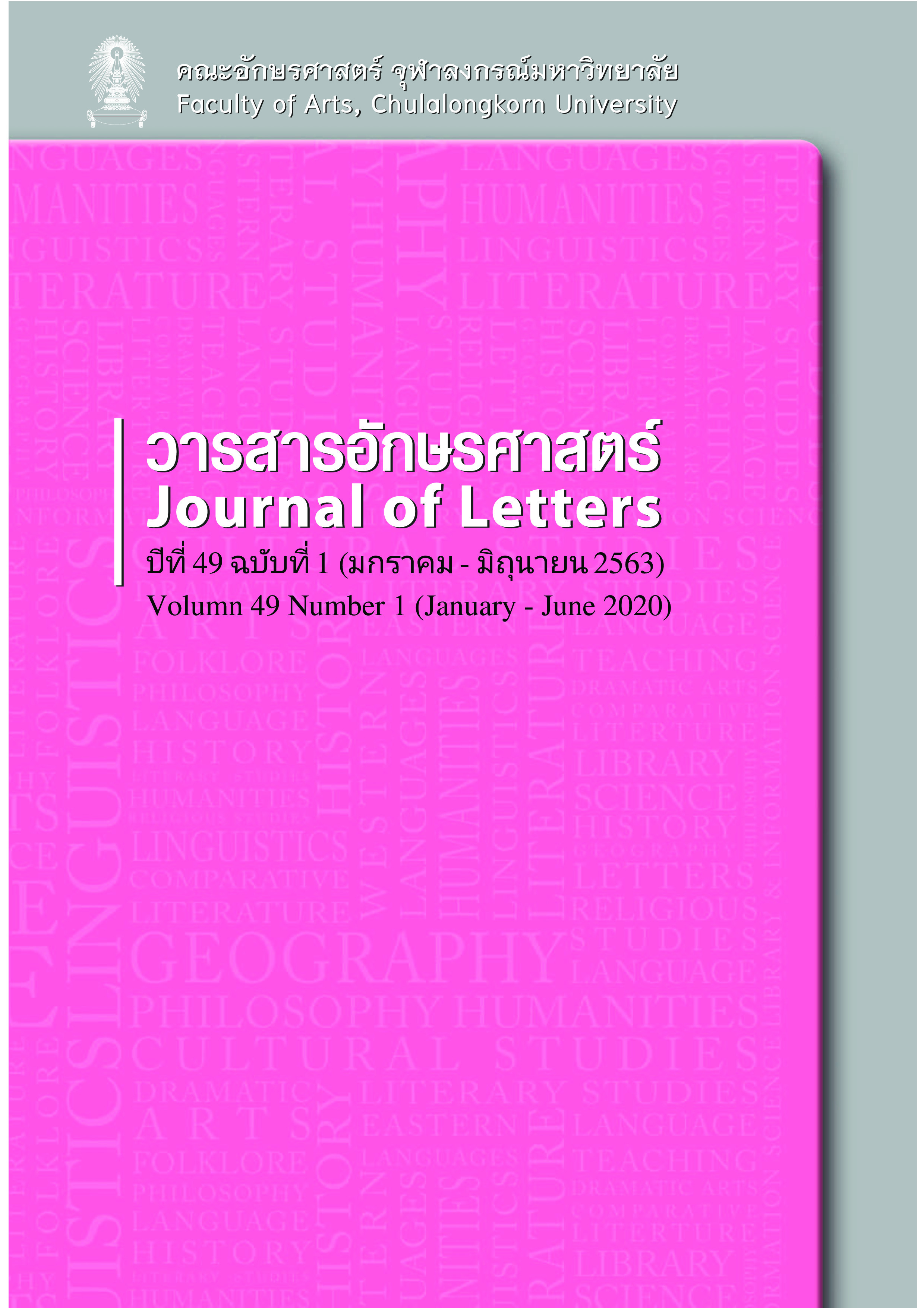Lao Substratum Influence on the Ideophones of Khorat Language
Keywords:
Khorat Language, Ideophones, Lao Substratum, Substratum Influence, Language ShiftAbstract
The origin of Khorat language has been a controversial issue among linguists. Three hypotheses are proposed. Firstly, Khorat is the result of the Yo system recoding to Bangkok Thai. Secondly, Khorat is a Lao dialect whose tones have been influenced by Central Thai. Thirdly, Khorat is a Lao dialect that has shifted to Thai but manifested Lao tone substratum. Most of the hypotheses, however, are based on phonological phenomena, especially the tone systems. In this article, evidence on category, structure and vocalic sound symbolism of ideophones in Khorat is proposed. It is found that some of the ideophone structures and vocalic sound symbolism in Khorat are exclusively the same as those in Lao. Therefore, the findings support the hypothesis that Khorat originated from a group of Lao speakers who had shifted their language to Thai but manifested Lao substratum influence on some ideophones.
References
ภาษาไทย / Thai
Chalida Rinprom ชลิดา รินทร์พรหม. 1977. “Rabop Nuaisiang nai Phasa Thin Khorat” ระบบหน่วยเสียงในภาษาถิ่นโคราช [The Phonemic System of the Khorat Dialect]. Master thesis, Chulalongkorn University.
Chuucheep Beadnok ชูชีพ เบียดนอก. 1989. “Kansuksa rueng sap nai phasa Thai thin Khorat” การศึกษาเรื่องศัพท์ในภาษาไทยถิ่นโคราช [A Study of Lexical Items in Khorat Dialect]. Master thesis, Silpakorn University.
Jiamsak Chanakha เจียมศักดิ์ ชนะค้า. 2010. “Khamwiset bok laksana nai phasa thin Khorat Amphoe Phimai Changwat Nakhon Ratchasima” คำวิเศษณ์บอกลักษณะในภาษาถิ่นโคราช อำเภอพิมาย จังหวัดนครราชสีมา [Descriptive Adverbs in Khorat Dialect Phi Mai District, Nakhon Ratchasima province]. Master Independent Study, Mahasarakham University.
Phinnarat Akharawatthanakun พิณรัตน์ อัครวัฒนากุล. 2003. “Kanplianplaeng khong wannayuk: Koranee suksa phasa klum Lao” การเปลี่ยนแปลงของวรรณยุกต์: กรณีศึกษาภาษากลุ่มลาว [Tone Change: A Case Study of the Lao Language]. Doctoral dissertation, Chulalongkorn University.
Suwilai Premsrirat et al. สุวิไล เปรมศรีรัตน์ และคณะ. 2004. Phaenthi phasa khong klum chattiphan tang tang nai prathet Thai แผนที่ภาษาของกลุ่มชาติพันธุ์ต่าง ๆ ในประเทศไทย [Ethnolinguistic Maps of Thailand]. Bangkok: Office of the National Culture Commission.
Thananan Trongdee ธนานันท์ ตรงดี. 2015. Rai-ngan wijai chabap somboon rueng khwam samphan thang chuesai nai phasa luk khong phasa Sakon Nakhon dangdoem รายงานวิจัยฉบับสมบูรณ์เรื่องความสัมพันธ์ทางเชื้อสายในภาษาลูกของภาษาสกลนครดั้งเดิม [Research Report on the Genetic Relationship among Daughter Languages of Proto Sakon Nakhon]. Mahasarakham: Mahasarakham University.
Toem Wiphakphachanakij เติม วิภาคย์พจนกิจ. 2014. Prawatsat Isan ประวัติศาสตร์อีสาน [History of Isan] (5th ed.). Bangkok: Thammasat University Press.
Vichin Panupong วิจินตน์ ภาณุพงศ์. 1983. Phumisat khamsap nai changwat Nakhon Ratchasima ภูมิศาสตร์คำศัพท์ในจังหวัดนครราชสีมา [Lexical Geography in Nakhon Ratchasima]. Warasarn Sat Heang Phasa วารสารศาสตร์แห่งภาษา [Journal of Science of Language] 3: 63-88.
ภาษาอังกฤษ / English
Brown, Marvin J. 1965. From Ancient Thai to Modern Dialects. Bangkok: Social Science Association Press.
Brown, Marvin J. 1985. From Ancient Thai to Modern Dialects and Other Writings on Historical Thai Linguistics. Bangkok: White Lotus Press.
Chamberlain, James R. 1972. Tone Borrowing in Five Northeastern Dialects. In Tai Phonetics and Phonology, Jimmy G. Harris and Richard B. Noss, eds., 43-46. Bangkok: Central Institute of English Language.
Chamberlain, James R. 1984. The Tai Dialects of Khammouan Province: Their Diversity and Origin. Science of Language, 4, 62-95.
Crisfield, Arthur G. 1978. “Sound Symbolism and the Expressive Words of Lao.” Doctoral dissertation, University of Hawaii.
Dingemanse, Mark. 2011. “The Meaning and Use of Ideophones in Siwu.” Doctoral dissertation, Radboud University, Nijimegan.
Dingemanse, Mark. 2012. Advances in the Cross-Linguistic Study of Ideophones. Language and Linguistic Compass 6(10): 645-672.
Gedney, William J. 1972. A Checklist for Determining Tones in Tai Dialects. In Studies in Linguistics in Honor of George L. Trager, ed. M. Estellie Smith, 423-437. The Hague: Mouton.
Jodking, Wutichai. 1980. “Some Characteristics of the /ɲɔ:/ Language at Sakon Nakhon.” Master thesis, Mahidol University.
LaPolla, Randy J. 2009. Causes and Effects of Substratum, Superstratum and Adstratum Influence with Reference to Tibeto-Burman Languages. Senri Ethnological Studies, 75, 227-237.
Downloads
Published
How to Cite
Issue
Section
License
Copyright and plagiarism
Authors are responsible for obtaining permission to use copyrighted materials from copyright owners. Authors are responsible for observing requisite copyright law when quoting or reproducing copyrighted materials. Quotations and reproductions of content from other published sources must be accompanied by a reference and all sources should be clearly listed in the references section. Quotations and reproductions of content from external sources without due attribution could be considered a severe infringement of academic conduct and may constitute a legal offence under the Copyright Act of B.E. 2537. Any legal ramifications arising from the infringement of copyright regulations would be the sole responsibility of the author(s).



